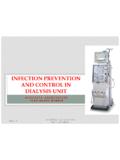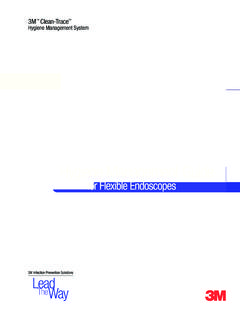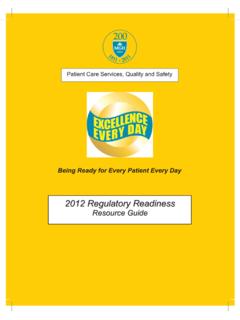Transcription of CDC Guidance for Control of Carbapenem-Resistant ...
1 Alice Guh, MD, MPH Division of Healthcare Quality Promotion Centers for Disease Control and prevention November 2, 2012 CDC Guidance for Control of Carbapenem-Resistant Enterobacteriaceae National Center for Emerging and Zoonotic Infectious Diseases Division of Healthcare Quality Promotion Carbapenem-Resistant Enterobacteriaceae (CRE) CRE emergence and dissemination represent serious public health threat Associated with high mortality rates Potential to spread widely Current US distribution of CRE likely heterogeneous Despite the widespread dissemination of KPC-producing CRE CRE found less frequently in some regions, more commonly in other regions ( , Northeast) There is still a critical opportunity for CRE Control 2009 CDC/HICPAC CRE Recommendations CRE in Long-Term Care Settings Not just in acute care hospitals Since 2004, reports of CRE cases from Long-term acute care hospitals (LTACHs) and LTCF CRE prevalence as high as 50%, even with few infections present Potential for large reservoir of patients with CRE Multiple comorbidities Concentrated in one location for extended period of time Inter-Facility Transmission of MDROs (Including CRE) Munoz-Price SL.
2 Clin Infect Dis 2009;49:438-43. Current CDC Guidance for CRE Control Requires coordinated regional effort involving all stakeholders Acute care and long term care facilities Public health Includes the following key principles: Recognizing the epidemiologic importance of CRE Understanding the prevalence of CRE within a given region Identifying colonized and infected patients in facilities Implementing regional and facility-based interventions to halt transmission 2012 CRE Toolkit Expands upon 2009 CDC/HICPAC recommendations: Facility-level recommendations Acute care facilities Long-term care facilities Regional prevention strategy for health department implementation Surveillance and Definitions Facilities/Regions should have an awareness of the prevalence of CRE in their facility/region Facilities look-back of lab records ( , 6-12 months) Could concentrate on select CRE Klebsiella spp.
3 , E. coli, Enterobacter spp. CDC definition (based on 2012 CLSI definitions): Nonsusceptible to one of the carbapenems (doripenem, meropenem, imipenem) Resistant to all 3rd generation cephalosporins tested Some Enterobacteriaceae are intrinsically resistant to imipenem (Morganella, Providencia, Proteus) FACILITY-LEVEL CRE prevention Facility-Level Measures: Acute and Long-Term Care Facilities Core Hand hygiene Contact Precautions HCP education Minimizing device use Patient and staff cohorting Laboratory notification Antimicrobial stewardship CRE Screening Supplemental Active surveillance cultures Chlorhexidine bathing Facility-Level Recommendations: Core Measures Hand Hygiene Educate staff with frequent in-services At orientation and periodically Monitor hand hygiene adherence and provide feedback of performance Ensure access to hand hygiene stations Install alcohol-based hand gel dispensers in/near patient rooms Encourage use of alcohol-based hand gel dispensers in favor of soap and water (exceptions include when hands are visibly soiled) Facility-Level Recommendations.
4 Core Measures Contact Precautions For patients colonized or infected with CRE Consider pre-emptive CP in patients transferred from high-risk settings Systems in place to identify patients at readmission Ensure proper PPE wear by HCP Monitor CP adherence and provide feedback No recommendations for discontinuation of CP Contact Precautions in Long-Term Care Facilities CP could be modified in these settings Apply CP to residents with CRE who are at higher risk for transmission Dependent upon HCP for their activities of daily living Ventilator-dependent Incontinent of stool Wounds with drainage that is difficult to Control For other residents (more functional), requirement for Contact Precautions might be relaxed Emphasize hand hygiene, keep wounds covered Standard Precautions should still be observed Facility-Level Recommendations: Core Measures HCP Education Regular education about MDRO prevention Hand hygiene Contact Precautions Appropriate handling/care of invasive devices Minimize use of invasive devices Ensure implementation of HICPAC recommendations: Urinary catheters Central lines Facility-Level Recommendations: Core Measures Device Use Facility-Level Recommendations: Core Measures Patient and Staff Cohorting Place CRE patients in single-patient rooms If not available, cohort patients together in same room Preference for single rooms should be given to patients at highest risk of transmission ( , stool incontinence, have medical devices, open wounds) Cohort CRE patients to specific areas ( , units or wards) with dedicated staff Facility-Level Recommendations.
5 Core Measures Laboratory Notification Perform appropriate laboratory screening for CRE (in accordance with CLSI Guidance ) Have protocols in place for timely notification of appropriate staff when CRE are isolated Applies to on-site and off-site laboratories Facility-Level Recommendations: Core Measures Promote Antimicrobial Stewardship Ensure appropriate indications and duration of use of antimicrobial therapy Use narrowest spectrum of antimicrobial that is appropriate Facility-Level Recommendations: Core Measures CRE Screening Used to identify unrecognized CRE colonization among high-risk patients ( , CRE contacts) Point prevalence surveys Rapid evaluation of CRE prevalence in particular wards/units Do once if few or no additional CRE colonized patients identified Do serially if colonization more widespread and/or to follow effect of intervention Screening of epi-linked patients, , roommates, patients who shared same HCP Typically obtain cultures of stool, rectal, or peri-rectal Link to laboratory protocol Facility-Level Recommendations: Supplemental Measures Active surveillance testing potential considerations.
6 Patients who may not be epi-links to CRE cases, but meet certain pre-specified criteria Admitted from high-risk settings , , ICUs, LTCFs Admitted from facilities with known CRE transmission Generally done at admission with preemptive isolation of patient until results available Chlorhexidine bathing limited evidence for CRE: Acute care facilities bathe patients with 2% chlorhexidine while in high-risk settings LTCF bathe high-risk patients with 2% chlorhexidine REGIONAL CRE prevention Regional Approach to MDRO (CRE) prevention is Essential Rationale for regional approach What happens in one facility will impact surrounding facilities Individual facilities can reduce MDRO prevalence only to a certain point Successful regional coordination by public health VRE Control in Siouxland region CRE containment in Israel Sohn AH et al. Am J Infect Control 2001;29:53-7. Schwaber MJ et al. Clin Infect Dis 2011;52:848-55.
7 Important Role of Public Health in CRE Control HDs in unique position to coordinate local and regional response to CRE Assess CRE prevalence/incidence within their jurisdiction in order to provide situational awareness to facilities Serve as resource to facilities about prevention options Regional prevention Strategy Health Department Coordination Aggressive approach to contain or prevent CRE emergence Regions with no CRE identified Regions with few CRE identified Broad approach is required in regions where CRE are common Regional prevention Strategy Regional Surveillance for CRE Determine CRE prevalence within a given jurisdiction Make CRE laboratory reportable (in regions with no known or few CRE) Survey IPs or lab directors Feedback of surveillance results Regional prevention Strategy Regions With No CRE Identified Aggressive efforts at detection: Perform periodic surveillance and feedback Frequency may depend on CRE prevalence in neighboring regions (establish mechanism for communication) Educate facility staff to increase awareness Epidemiologic importance of CRE Recommended surveillance and prevention measures Regional prevention Strategy Regions With Few CRE Identified Aggressive efforts at containment, may target select areas: Implement infection prevention measures Reinforce core prevention measures in all facilities Facilities with CRE: promote CRE screening and consider supplemental measures Facilities without CRE.
8 Targeted surveillance testing, preemptive CP Use inter-facility patient transfer forms Indicate CRE status, open wounds/devices, antimicrobial therapy Educate facility staff to increase awareness Perform periodic surveillance and feedback Regional prevention Strategy Regions Where CRE Are Common Implementation of measures across all facilities: Dedicated HD personnel to engage facilities (including facility leadership) Reinforce core prevention measures and implement supplemental measures Regularly assess for compliance to prevention measures Share performance measures with facility leadership Use inter-facility patient transfer forms Perform periodic surveillance and feedback Assess efficacy of interventions Consider reporting of certain CRE events ( , fatalities) Practical Steps for Implementing Regional CRE prevention Strategy Example strategies from 3 states: WI, OR, UT Components include: Establish advisory group of key stakeholders (IPs, ID physicians, LTCF representatives, Laboratory Directors, etc.)
9 Conduct surveillance for select CRE (lab reportable, NHSN) Follow up on every CRE case track patient movement across healthcare settings to ensure recommendations implemented Improve interfacility communication of CRE patient transfers Engage Hospital Preparedness and EMS personnel Work with neighboring states to track transmission between states Engage Local Health Departments Provide educational seminars and materials, including patient FAQs For more information please contact Centers for Disease Control and prevention 1600 Clifton Road NE, Atlanta, GA 30333 Telephone, 1-800-CDC-INFO (232-4636)/TTY: 1-888-232-6348 E-mail: Web: The findings and conclusions in this report are those of the authors and do not necessarily represent the official position of the Centers for Disease Control and prevention . National Center for Emerging and Zoonotic Infectious Diseases Division of Healthcare Quality Promotion Thank you
















